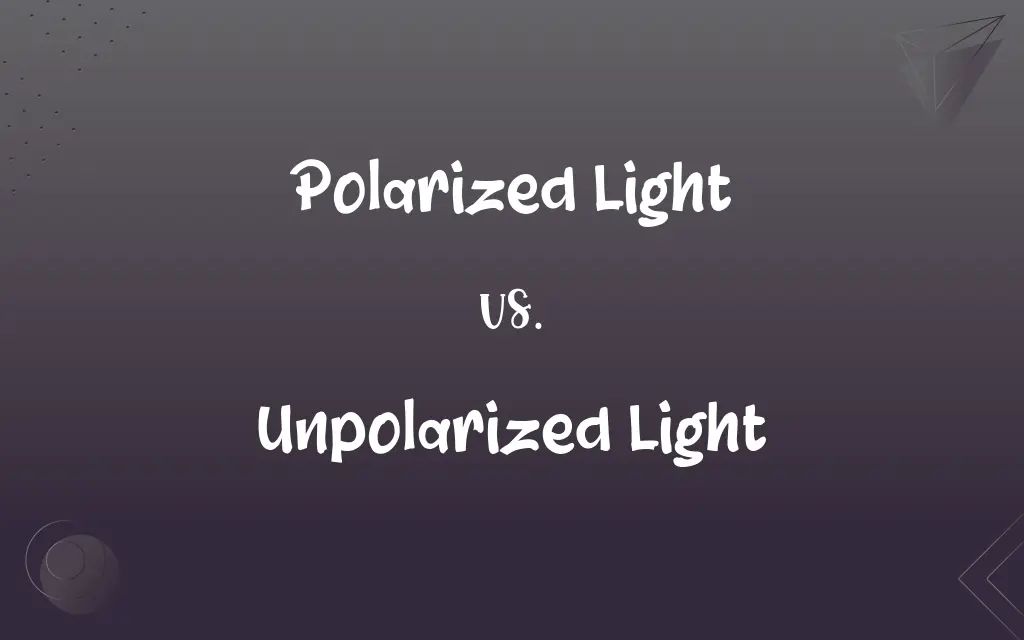Polarized Light vs. Unpolarized Light: What's the Difference?
Edited by Janet White || By Harlon Moss || Updated on October 3, 2023
Polarized Light is light waves where vibrations occur in a single plane, while Unpolarized Light has waves vibrating in multiple planes.

Key Differences
Polarized light consists of light waves that oscillate or vibrate in a singular plane, maintaining a consistent orientation. Unpolarized light, in stark contrast, exhibits light waves that oscillate in multiple, random planes, lacking a specified directionality.
To convert unpolarized light into polarized light, one common method is to use a polarizing filter, which allows light waves vibrating in one plane to pass through. Unpolarized light does not undergo such a filtering process and thus retains its multidirectional vibrational characteristics.
Polarized light is strategically employed in various technological applications, such as reducing glare in sunglasses and improving visual clarity in LCD screens. Unpolarized light is naturally occurring and is what we typically encounter in everyday environments without technological intervention.
In scientific contexts, polarized light is crucial for certain experimental setups, such as those in quantum mechanics or optical microscopy, due to its predictability and consistency. Unpolarized light is less frequently utilized in precise scientific applications due to its erratic vibrational nature.
When interacting with surfaces, polarized light can reduce glare from reflective surfaces like water or glass, enhancing visual perception. Unpolarized light, conversely, can produce glare and is often considered to be visually disruptive in certain situations.
ADVERTISEMENT
Comparison Chart
Vibration Plane
Single plane
Multiple planes
Creation
Can be created by passing light through a polarizer
Naturally occurring
Usage in Technology
Used in sunglasses, screens, and scientific experiments
Rarely used in technology for visual clarity
Predictability
Predictable wave vibrations
Unpredictable and random wave vibrations
Glare
Reduces glare
Can cause glare
ADVERTISEMENT
Polarized Light and Unpolarized Light Definitions
Polarized Light
Polarized light is essential in various optical applications for clarity.
Photographers often use polarized filters to enhance image color and contrast.
Unpolarized Light
Unpolarized light contains wave vibrations in assorted directions and amplitudes.
Light emitted from a distant star reaches Earth as unpolarized light, scattering in space.
Polarized Light
Polarized light exhibits a consistent wave vibration directionality.
Researchers utilize polarized light to explore optical phenomena in laboratories.
Unpolarized Light
Unpolarized light features vibrations occurring in multiple, arbitrary planes.
Standard light bulbs emit unpolarized light into the room.
Polarized Light
In polarized light, the electric field oscillates uniformly.
Scientists use polarized light to study molecular structures.
Unpolarized Light
Unpolarized light is commonly found in natural and artificial light sources without intervention.
Light from a candle flame spreads as unpolarized light in a room.
Polarized Light
Polarized light vibrates in a singular, specific plane.
Sunglasses utilize polarized light to diminish glare from sunlight.
Unpolarized Light
Unpolarized light does not have a specific directionality in its wave oscillations.
The sun emits unpolarized light that scatters in all directions in the atmosphere.
Polarized Light
Polarized light can be produced by passing light through a polarization filter.
The glare-free image on an LCD screen is achieved through polarized light.
Unpolarized Light
Unpolarized light can be converted into polarized light using a filter.
Unpolarized light from a flashlight can be polarized using a special lens.
FAQs
Is natural light from the sun polarized or unpolarized?
Sunlight is generally unpolarized, with light waves vibrating in multiple planes.
Can unpolarized light be converted to polarized light?
Yes, unpolarized light can be converted to polarized light using a polarizing filter.
Why is polarized light beneficial in scientific experiments?
Polarized light is beneficial due to its consistent and predictable vibrational nature, aiding precise measurements.
What is polarized light used for in everyday objects?
Polarized light is used in sunglasses and screens to reduce glare and enhance visual clarity.
Does unpolarized light cause more glare than polarized light?
Yes, unpolarized light can cause more glare, especially when reflecting off surfaces, compared to polarized light.
Can the human eye naturally differentiate between polarized and unpolarized light?
The human eye cannot inherently differentiate between polarized and unpolarized light without assistance, such as through polarized lenses which manage glare and improve contrast.
How does unpolarized light interact with a polarizing filter?
Unpolarized light, when passing through a polarizing filter, becomes polarized as only the light waves oscillating in the filter’s direction are allowed through.
How does polarized light affect the visibility of objects underwater?
Polarized light reduces surface glare, enhancing visibility of objects underwater by allowing clearer viewing through the water’s surface.
How does a polarizing filter generate polarized light?
A polarizing filter allows only the light waves that oscillate in one specific direction to pass through, thereby generating polarized light.
Are there specific instruments to measure the degree of polarization in light?
Yes, polarimeters and photometers with polarizing filters can measure the degree and direction of polarization in light.
Does reflected light become polarized, and how does this impact vision?
Yes, light can become partially polarized upon reflection, which can cause glare and hamper clear vision without polarized eyewear.
Is the light from our household bulbs typically polarized or unpolarized?
Household bulbs typically emit unpolarized light, with waves vibrating in various planes.
Can polarized light impact the colors perceived by the human eye?
Yes, polarized light can enhance color contrast and sharpness, making colors appear more vivid in certain conditions.
How is unpolarized light produced artificially?
Artificially, unpolarized light is typically produced by common light sources like bulbs and LEDs, where emitted light waves vibrate in multiple directions.
Why do fishermen and boaters often wear polarized sunglasses?
Polarized sunglasses reduce the glare from the water's surface, enhancing depth perception and reducing eye strain for fishermen and boaters.
About Author
Written by
Harlon MossHarlon is a seasoned quality moderator and accomplished content writer for Difference Wiki. An alumnus of the prestigious University of California, he earned his degree in Computer Science. Leveraging his academic background, Harlon brings a meticulous and informed perspective to his work, ensuring content accuracy and excellence.
Edited by
Janet WhiteJanet White has been an esteemed writer and blogger for Difference Wiki. Holding a Master's degree in Science and Medical Journalism from the prestigious Boston University, she has consistently demonstrated her expertise and passion for her field. When she's not immersed in her work, Janet relishes her time exercising, delving into a good book, and cherishing moments with friends and family.































































